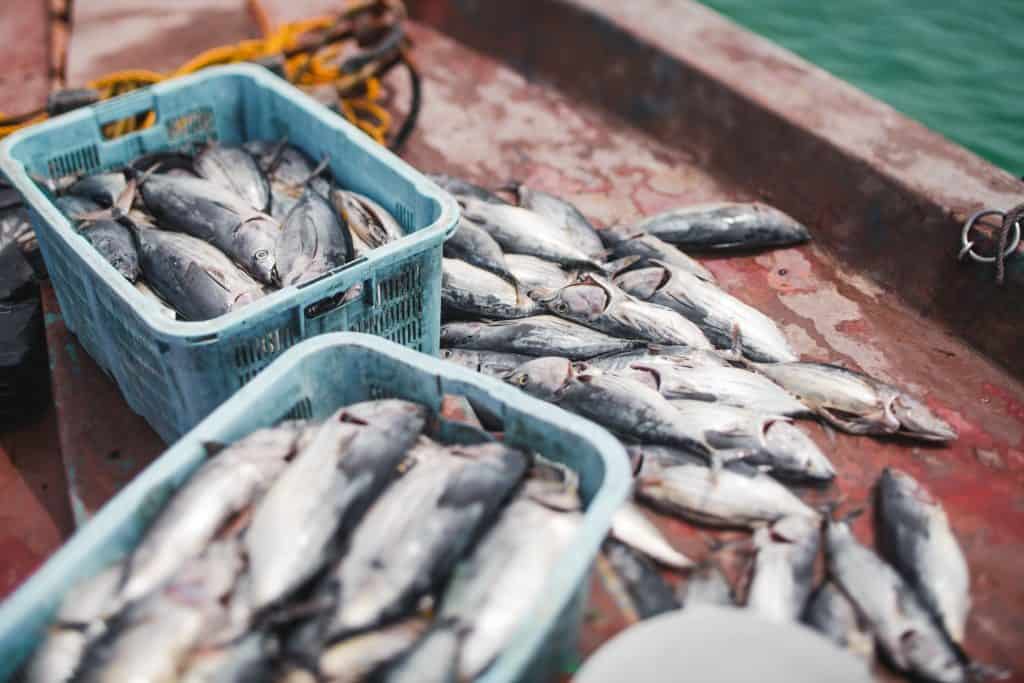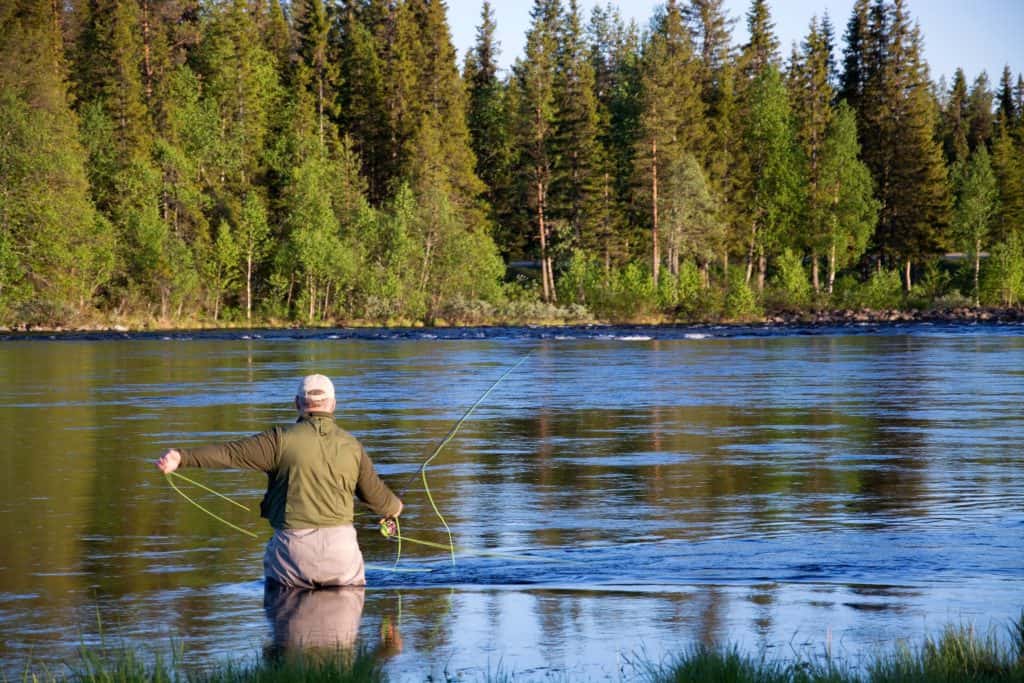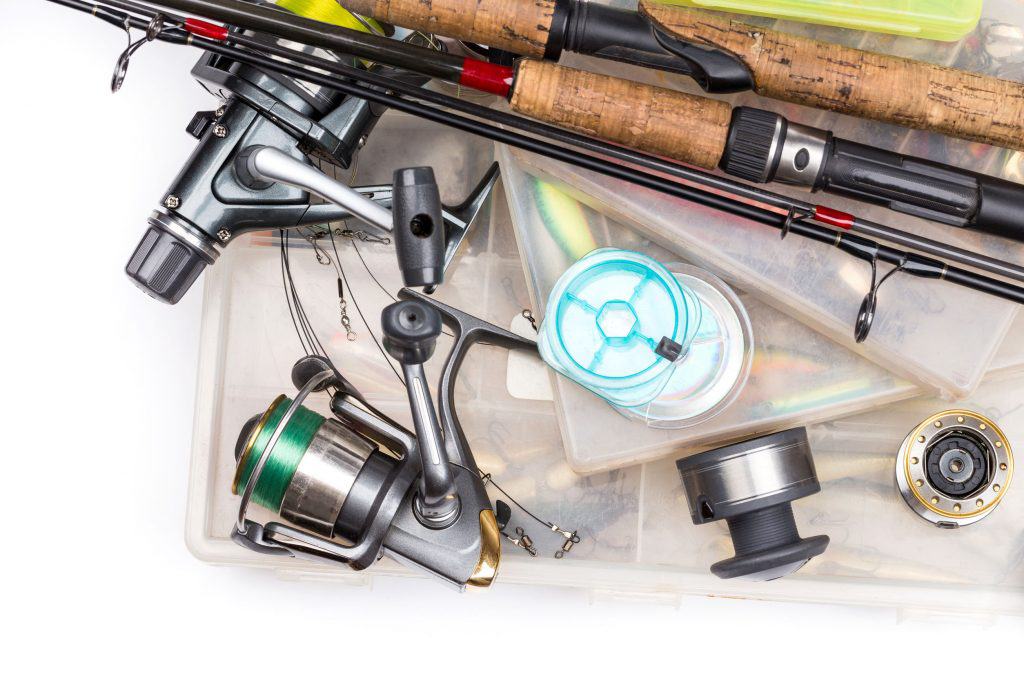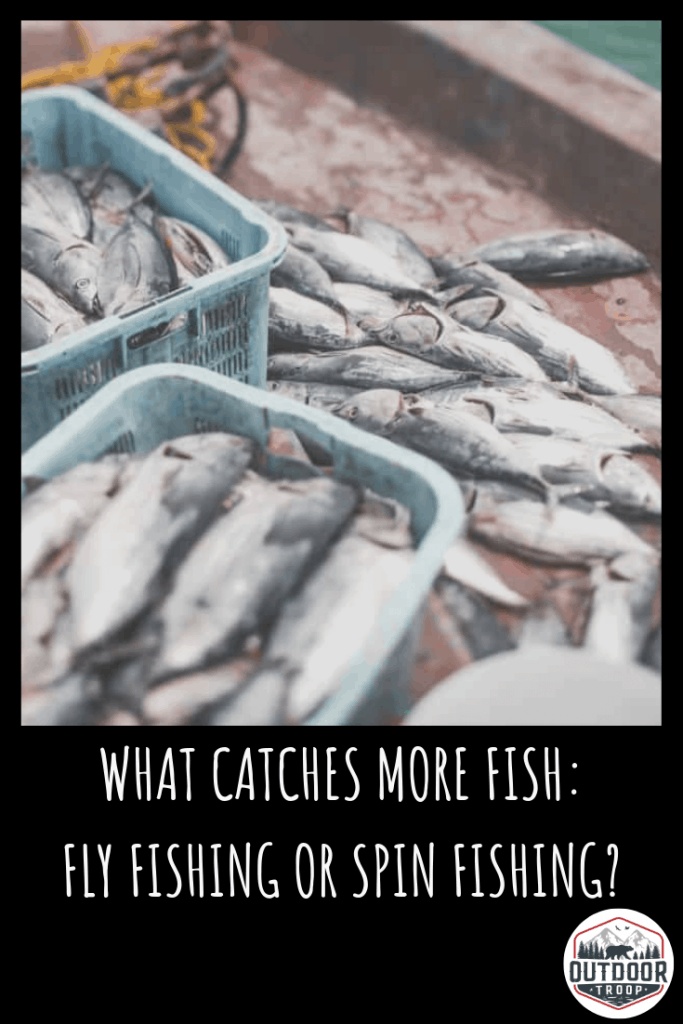
I think for many beginner fisherman, it can be confusing to know the differences between each of the different styles of fishing. It can be even more confusing to know which of these styles is going to help you catch more fish. So let’s look a little more into it.
Does fly fishing catch more fish than regular spin fishing? The most effective fishing method depends both on the type of fish you are trying to catch, the bait you are using, the bait or
The differences between the styles of fly fishing and regular spin fishing gives each a unique advantage in different situations. Since each is designed to deliver a different type of lure, fly, or bait to the fish, one style may be more useful in one situation and less in another. To learn more about the differences between the styles of fishing and their unique advantages, continue reading below!
The True Differences
Before we discuss the advantages of both fly fishing and regular spin fishing, we need to first begin to understand the true differences in how the different styles operate and how they deliver the hooks differently.
| Detail | Spin Fishing | Fly Fishing |
| Rod | Heavier, sturdier | Lightweight, flexible |
| Flies or Lures | Heavier spin lure used to imitate baitfish | Lightweight flies uses to imitate the fish’s food |
| Line | Monofilament, or lighter line used for heavier lures | Fly fline, leader, tippet |
| Location | Primarily on lakes | Primarily on rivers |
Regular Spin Fishing
When spin fishing, you use a different rod than you would for fly fishing. The rod used for spin fishing is typically heavier and casts with a single monofilament line.
At the end of the line, there is a spinning lure (which is where this tactic gets its name from) which is used to entice the fish to bite the hook. These lures are heavy and are meant to imitate the baitfish that many
Crank and resistance lures can only be used with a spin fishing rod, which creates another advantage to this fishing style.
While regular spin fishing can be done in both fresh and saltwater environments, making it a versatile technique, it is typically used on still water, such as lakes, rather than on rivers or streams.
Spin fishing was designed to help fishermen catch more fish in one trip, and this method is effective on most fish (except trout). Spin fishing may also help you to catch more fish because it is easier than fly fishing.
So if you are struggling to fly fish and just want an easier tactic to try, test out some spin fishing. Spin fishing tends to be less complicated and easier to learn than fly
Fly Fishing
Fly fishing was invented in the early first or second century in Macedonia by some hopeful fishermen.
They designed rods and artificial flies to help them catch a specific species of fish in an effective way. Fly fishing rods have evolved, but
A fly rod is lightweight and tends to be more flexible than other styles of fishing rods. However, fly rods can vary in detail depending on what tactic the rod has been specifically designed for.
Rather than casting a lure or a baited hook, fly fishing uses a fly line, leader, and tippet to cast a usually small lightweight fly. These flies also vary in size, style, and material based on what species of fish you are trying to catch.
The flies are different depending on what form of food you are trying to imitate. And believe me there is a different fly for every different form of food a fish eats.
While fly fishing can be used on both still and moving water, it is more commonly used by those who want to fish rivers and streams.
Based on the rod and fly alone, you can tell that fly fishing was not designed to catch a large amount of fish, but rather is designed to be customizable to the fisherman’s needs and the fish they are looking for.
The Advantages
While each of the fishing styles is different, they all offer unique advantages in specific situations.
Fly Fishing

One of the unique things about fly fishing is that each detail of your cast is customizable in order to more specifically target the fish you are going for.
You can purchase a general use fly rod, or you can find rods that have been specifically designed to aid you in specific ways.
After personalizing your rod, you have the ability to personalize your line by changing the length, style, and weight. In changing your line to greater meet your needs, you have the ability to adjust the leader and tippet.
If you want a longer or shorter leader this can easily be achieved with fly fishing.
As for tippets, there are different styles and of tippets you can use with your line. The tippet and leader are used to make the line nearly invisible to the fish. Tippets also make it easier to attach and detach your flies to and from your line, making for a quick and easy transition between casts.
Speaking of the flies, these are one of the most customized parts of fly fishing. You can purchase many different flies that will help attract the fish you are wanting to catch, or you can watch your surroundings, do some research, and tie your own flies to have the “ultra-customized” fly fishing fly.
Another advantage that comes in fly fishing is that when a cast is done correctly, the fly is delivered in an inconspicuous way to the fish.
The fly is cast against the current and then allowed to drift for a distance just as a normal bug falling into the moving water would.
One of the fly fishermen’s greatest goals is to deliver the fly in such a way that the fish does not suspect there is anything unnatural about the fly floating above them. If they’re fooled, they’ll take a bite on the line.
Fly fishing is a great way to catch all kinds of trout, bass, bluegills, and many other species of river fish.
Regular Spin Fishing

As I mentioned above, spin fishing is not designed to be as customizable as fly fishing. However, spin fishing is designed to catch more fish in a faster manner than fly fishing does.
Spin fishing rods tend to be cheaper than fly fishing rods (by a couple hundred dollars) and are usually easier to use.
The line used for spin fishing is different from that of fly line. Fly line is made a little heavier to help cast the lighter fly over a greater distance; however, spin fishing uses a heavier lure and therefore does not need the added weight to help the lure travel a frther distance.
Spin fishing then uses a lighter line such as a monofilament or braided design matched to support the weight of the fish they will be catching.
Spinning lures are typically smaller and shinier in hopes they imitate small baitfish and attract the larger target fish. These lures do not give you as much freedom in design as flies do, but they do work to attract more fish overall.
Another advantage that comes along with spin fishing is that it benefits many people who are beginner fishermen. Since spin fishing is easier than many other fishing techniques, the amount of time needed to learn how to spin fish properly is shorter than that of other techniques.
The gear used for spin fishing creates even greater advantages in windy or harsh weather. Casting a light lure into the wind only helps the lure travel further and can help you to reach the perfect spot that you couldn’t before.
Spin fishing allows the lure to sink with much less resistance than that of other fishing styles as well. A benefit over fly fishing is that the lure does sink and doesn’t just float on the surface.
When fighting a fish, spin fishing allows the fisherman to adjust his drag easy. Doing so helps to win the fight with the fish much quicker and easier than other tactics.
Unlike regular fishing rods, spin fishing rods are not specified for left-hand or right-handed use, but are ambidextrous and can be used by anybody. This aspect can make spin rods more desirable if you want to share with someone who does not share the same dominant hand as you.
Which Method To Use
Now that we know the differences and advantages of fly fishing and spin fishing, it is important to know which method is going to benefit you while you are fishing.
Below I have some lists that show the top 10 fish species each method is best designed to catch.
Spin Fishing
(As a quick disclaimer, spin fishing can be successful at catching most species of fish and these are just the ten most common species caught.)
- Perch
- Salmon
- Trout
- Bream
- Pike
- Walleye
- Blue Kuper
- Bass
- Chub
- Zander
Fly Fishing
- Trout
- Grayling
- Salmon
- Pike
- Bass
- Panfish
- Carp
- Tarpon
- Tuna
- Bonefish
Fishing Tips
Regular Spin Fishing

#1 Choose the Correct Line
There are many different kinds of lines that are sold today. One of the most common and compatible with a spinning setup is a braided line. This type of line is smaller, stronger, and casts farther than many other types of line.
The downside to the braided line is that it is visible to the fish who are swimming beneath the water. If a fish can tell that there’s a line on the water, they’re harder to fool. B
#2 Don’t Under or Over Fill Your Spool
You do not want to have either an underfilled or overfilled spool when you’re out spin fishing.
If you underfill the spool, you will be limiting your casting distance more than you want. On the other hand, if you overfill the spool, the line will begin coming out the second the bail is opened. This might cause you to overshoot your target and mess up your aim.
My tip for filling the spool is to leave at least 1/8 of an inch between the line and the outer edge of the spool.
#3 Go Twist Free
If you have ever fished at all (whether fly fishing or spin fishing) you know the dreaded twists that can come from the line being wrapped around the spool for so long. These twists can cause difficulty when you want to tie on your lures.
Getting twists out of your line might take a little bit of extra work, but it’s well worth it. To begin, stretch your line out in a wide open space (
If you need a quick fix out on the water, cut the lure off your line and let your line float in the water behind you for a short amount of time. The twists should come out on their own!
#4 Use Your Hand
Many spin rods close the bail automatically when you move the handle. However, to avoid causing any twists or knots in the line simply shut the bail by hand.
This may be a simple tip, but it will help you have a less stressful fishing trip by avoiding any knots in the line.
#5 Use Your Fingers Too!
To better control the distance and speed of your cast while spin fishing, gently put your pointerfinger on the line where it exits the spool.
By applying slight pressure to the line, you can have more control in directing your lure to the desired location.
You should continue to apply pressure as you reel the line back in as well. Reeling in line with slack will cause loops on the spool and problems down the line (literally!).
Avoid these loops by providing the needed tension on the line as it enters the spool again.
Fly Fishing
#1 Watch the Bugs
Before you start casting away, pay attention to the bugs that on and near the water and what kinds the fish are eating.
Take this into
#2 Test Your Leader Length
Depending on what fly and technique you are using, you may want either a longer or shorter leader length.
For dry or wet flies, try using a longer leader. You could use anywhere as much as 12 to 20 feet. If you are using a streamer opt for a shorter leader of 7 to 8 feet.
It is perfectly okay to test different lengths on your leader to find which works best for you and the fish.
#3 Don’t Overcast the Fish
Catching a fish does not always require a long cast. You never know what fish could be sitting directly in front of you.
Check the area closer to you before attempting to catch a fish from further away. Besides, it’s easier to set the hook from a shorter distance than from further away.
#4 Use the Whole Rod
May fishermen think that the straighter in the air their rod is, the more likely they are to win the fight against the fish. However, this more commonly just breaks either the line or the rod, and neither is desirable.
Keep your rod closer to a 45 degree angle so that hte entire rod is being used not just the tip. Fighting the fish takes skill more than it does strength.
#5 Cast From the Wrist
A good cast does not require the whole arm to be used but focuses more on the wrist’s movements. Your wrist should be straight but still relaxed. The rod should be doing most of the work for you.
Getting the perfect cast takes lots of practice and the best way to master it is to get out there and start fishing!
Related Questions
Can you fly fish with a normal rod? While it is possible to fly fish with a normal rod, you will still need to use some fly line. Also, since the weight and length of the line and rod will be different casting a fly across a long distance will be extremely difficult, if not impossible.
Will a longer rod cast further than a shorter rod? The longer a rod, the more power it can deliver during the cast. However, if you are using a light lure, a longer rod will make it harder to manage where the cast is directed to. The reach of the cast depends on the weight of the lure you are using, and the type of fish you are hoping to catch.

